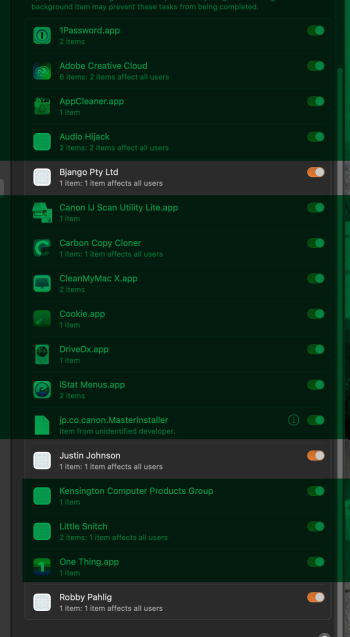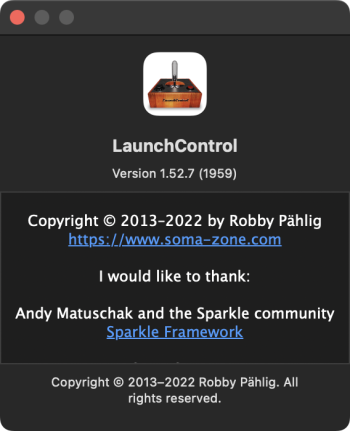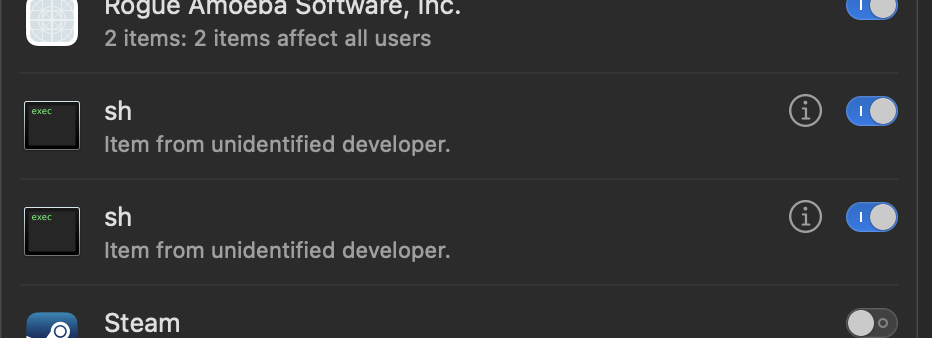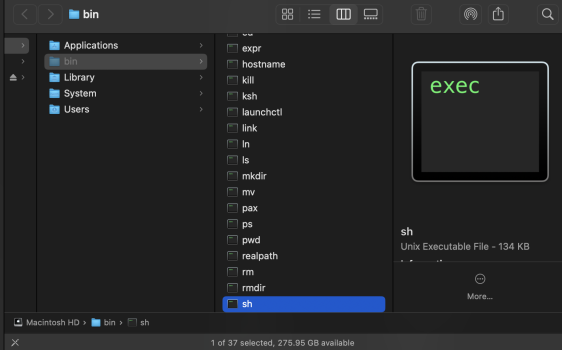Has anyone seen this name listed in some menu of our latest system software or third party installs? I have installed Ventura 13. I have a feeling that he is the author of some software I have installed. I have searched throughout the SSD and all my externals, but they do not show any file named such. The name appeared in a menu, but I can't find the exact menu any longer. I don't understand if it shows in the menu why I can't find it.
Got a tip for us?
Let us know
Become a MacRumors Supporter for $50/year with no ads, ability to filter front page stories, and private forums.
Who is Robby Pahlig in my iMac?
- Thread starter blackxacto
- Start date
- Sort by reaction score
You are using an out of date browser. It may not display this or other websites correctly.
You should upgrade or use an alternative browser.
You should upgrade or use an alternative browser.
I have the same, Google wasn't being helpful.
Obviously it's a developers name.
Searched through my ~/Library folder, nothing.
EDIT: I've got it!
We must both have software from https://soma-zone.com/
I have Launch Control, which is developed by... Robby Pählig!
Obviously it's a developers name.
Searched through my ~/Library folder, nothing.
EDIT: I've got it!
We must both have software from https://soma-zone.com/
I have Launch Control, which is developed by... Robby Pählig!
Attachments
Looking at your screenshot again @blackxacto , Bjango is iStat Menus etc, and Justin Johnson is a developer's name. https://apps.apple.com/us/developer/justin-johnson/id431224320
Yes, i know all those, but RobbyLooking at your screenshot again @blackxacto , Bjango is iStat Menus etc, and Justin Johnson is a developer's name. https://apps.apple.com/us/developer/justin-johnson/id431224320
Yes, i use BackupLoupe. Thank you very much for your help, guy’s!I have the same, Google wasn't being helpful.
Obviously it's a developers name.
Searched through my ~/Library folder, nothing.
EDIT: I've got it!
We must both have software from https://soma-zone.com/
I have Launch Control, which is developed by... Robby Pählig!
I appreciate the granular control and transparency with this new "allow in background" section -- but it's all a bit raw. I feel like they're surfacing some detail in the software that was never intended to be user-facing.
This is exactly the issue here. What shows is the name that's on the account used to sign the app, and it's going to cause more issues than it solves, I think. There needs to be a clear way to show exactly what the item is the list is referring to.I appreciate the granular control and transparency with this new "allow in background" section -- but it's all a bit raw. I feel like they're surfacing some detail in the software that was never intended to be user-facing.
For unsigned items, it's easy enough to look at exactly what file is being referred to, by clicking the little "i" in the list.
You're most welcome.Yes, i use BackupLoupe. Thank you very much for your help, guy’s!
that and the fact that apple's own sh file says it's from an unidentified developer.....This is exactly the issue here. What shows is the name that's on the account used to sign the app, and it's going to cause more issues than it solves, I think. There needs to be a clear way to show exactly what the item is the list is referring to.
For unsigned items, it's easy enough to look at exactly what file is being referred to, by clicking the little "i" in the list.
Attachments
Btw, and about looking at your LaunchControl screenshot: I've been using LaunchControl for a long time too, and just recently stumbled across LaunchControl 2. That has a completely redesigned UI and some (for my taste) big improvements in usability and functionality.
I'm just guessing here... but that's probably because it's an unmodified stock component of the BSD underpinnings. If Apple made no changes to the original file, they also wouldn't have had a reason to sign it.that and the fact that apple's own sh file says it's from an unidentified developer.....
Fair enough, but they need to refine the Login Items "Allow in the Background" list to give more information to enable the poor user to decide which items need to be enabled and which don't. All of the shell commands which are listed should probably be excluded from the list?I'm just guessing here... but that's probably because it's an unmodified stock component of the BSD underpinnings. If Apple made no changes to the original file, they also wouldn't have had a reason to sign it.
Also there is a confusion between the "Open at Login" list and the "Allow in Background" list - both seem to pretty much do the same thing but one is presumably under direct control of the user (the first) and the second is set by the process, but now the user has the theoretical ability to override what the process wants to do. But some, such as in my case Dropbox, appear in both. Giving power to the user is a Good Thing, with the mild caveat that it needs to be clear how and when to wield that power, and what effect it will have.
In all cases it seems to me that at least you should be able to click on a little "i" to see where the original file is located, like with the shell commands. An example here is that I have three entries for CleanMyMac X, and I have no way of knowing whether some of these are hangovers from previous versions, or are all of them valid?
Maybe this is a job for CleanMyMac itself to sort out!
If I may, I don't think " clean my mac " is necessary at all.... i think it will add unnecessary bloat to your system.Fair enough, but they need to refine the Login Items "Allow in the Background" list to give more information to enable the poor user to decide which items need to be enabled and which don't. All of the shell commands which are listed should probably be excluded from the list?
Also there is a confusion between the "Open at Login" list and the "Allow in Background" list - both seem to pretty much do the same thing but one is presumably under direct control of the user (the first) and the second is set by the process, but now the user has the theoretical ability to override what the process wants to do. But some, such as in my case Dropbox, appear in both. Giving power to the user is a Good Thing, with the mild caveat that it needs to be clear how and when to wield that power, and what effect it will have.
In all cases it seems to me that at least you should be able to click on a little "i" to see where the original file is located, like with the shell commands. An example here is that I have three entries for CleanMyMac X, and I have no way of knowing whether some of these are hangovers from previous versions, or are all of them valid?
Maybe this is a job for CleanMyMac itself to sort out!
All the tools it has are either already available in the operating system or have friendlier, less 'bloaty' alternatives.
The myth of the dirty Mac - The Safe Mac
An oft-asked question by many Mac users is “How do I clean my Mac’s system?” The advice they frequently receive involves things like deleting log files, clearing caches, removing cookies and all manner of other things. There are dozens of utilities that help users do these tasks. So, which...
 www.thesafemac.com
www.thesafemac.com
-
I think Open at Login is different to Allow in Background, as the former is the classical functionality of having an application open as you start the computer, while the latter is actually information that was previously hidden, and could only be viewed with things like LaunchControl, mentioned earlier in the thread.
I appreciate having access to both, as now when I install a new app the system will notify me that that app intends to run stuff in the background, like an update checker for example, and I can individually choose to ignore it or turn it off.
Really suits me and how I use the computer, but maybe different for you
Register on MacRumors! This sidebar will go away, and you'll see fewer ads.





